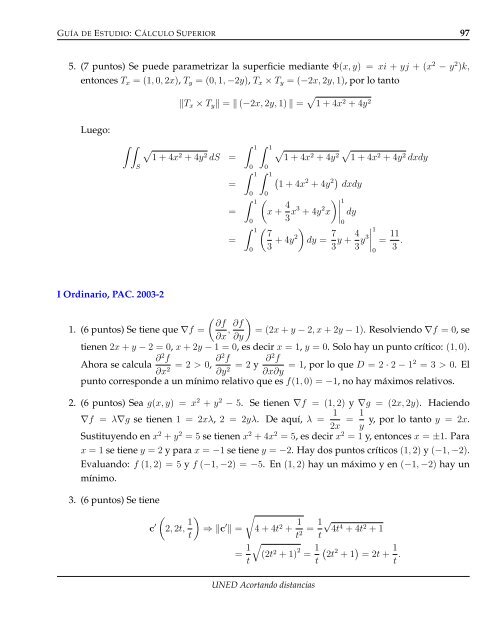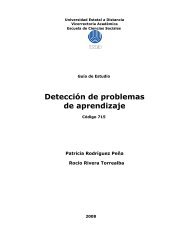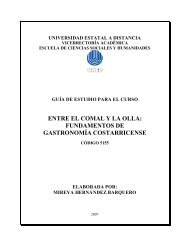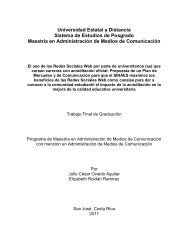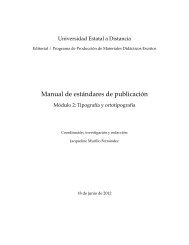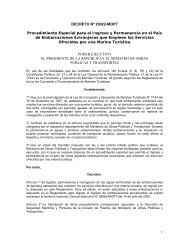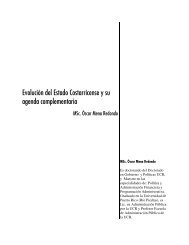GE3011 Cálculo Superior - Repositorio de la Universidad Estatal a ...
GE3011 Cálculo Superior - Repositorio de la Universidad Estatal a ...
GE3011 Cálculo Superior - Repositorio de la Universidad Estatal a ...
Create successful ePaper yourself
Turn your PDF publications into a flip-book with our unique Google optimized e-Paper software.
GUÍA DE ESTUDIO: CÁLCULO SUPERIOR 97<br />
5. (7 puntos) Se pue<strong>de</strong> parametrizar <strong>la</strong> superficie mediante Φ(x, y) = xi + yj + (x 2 − y 2 )k,<br />
entonces Tx = (1, 0, 2x), Ty = (0, 1, −2y), Tx × Ty = (−2x, 2y, 1), por lo tanto<br />
Luego:<br />
<br />
I Ordinario, PAC. 2003-2<br />
S<br />
Tx × Ty = (−2x, 2y, 1) = 1 + 4x 2 + 4y 2<br />
1 + 4x 2 + 4y 2 dS =<br />
=<br />
=<br />
=<br />
1 1<br />
0 0<br />
1 1<br />
0<br />
1<br />
0<br />
1<br />
0<br />
0<br />
1 + 4x 2 + 4y 2 1 + 4x 2 + 4y 2 dxdy<br />
1 + 4x 2 + 4y 2 dxdy<br />
<br />
x + 4<br />
<br />
7<br />
+ 4y2<br />
3<br />
3 x3 + 4y 2 1 <br />
x<br />
<br />
0<br />
dy<br />
dy = 7 4<br />
y +<br />
3<br />
3 y3<br />
<br />
<br />
<br />
<br />
1<br />
0<br />
= 11<br />
3 .<br />
<br />
∂f ∂f<br />
1. (6 puntos) Se tiene que ∇f = , = (2x + y − 2, x + 2y − 1). Resolviendo ∇f = 0, se<br />
∂x ∂y<br />
tienen 2x + y − 2 = 0, x + 2y − 1 = 0, es <strong>de</strong>cir x = 1, y = 0. Solo hay un punto crítico: (1, 0).<br />
Ahora se calcu<strong>la</strong> ∂2f ∂x2 = 2 > 0, ∂2f ∂y2 = 2 y ∂2f ∂x∂y = 1, por lo que D = 2 · 2 − 12 = 3 > 0. El<br />
punto correspon<strong>de</strong> a un mínimo re<strong>la</strong>tivo que es f(1, 0) = −1, no hay máximos re<strong>la</strong>tivos.<br />
2. (6 puntos) Sea g(x, y) = x2 + y2 − 5. Se tienen ∇f = (1, 2) y ∇g = (2x, 2y). Haciendo<br />
∇f = λ∇g se tienen 1 = 2xλ, 2 = 2yλ. De aquí, λ = 1 1<br />
= y, por lo tanto y = 2x.<br />
2x y<br />
Sustituyendo en x2 + y2 = 5 se tienen x2 + 4x2 = 5, es <strong>de</strong>cir x2 = 1 y, entonces x = ±1. Para<br />
x = 1 se tiene y = 2 y para x = −1 se tiene y = −2. Hay dos puntos críticos (1, 2) y (−1, −2).<br />
Evaluando: f (1, 2) = 5 y f (−1, −2) = −5. En (1, 2) hay un máximo y en (−1, −2) hay un<br />
mínimo.<br />
3. (6 puntos) Se tiene<br />
c ′<br />
<br />
2, 2t, 1<br />
<br />
⇒ c<br />
t<br />
′ <br />
= 4 + 4t2 + 1 1√<br />
= 4t4 + 4t2 + 1<br />
t2 t<br />
= 1<br />
<br />
(2t<br />
t<br />
2 + 1) 2 = 1 2 1<br />
2t + 1 = 2t +<br />
t<br />
t .<br />
UNED Acortando distancias


